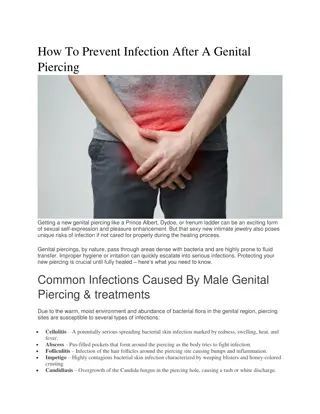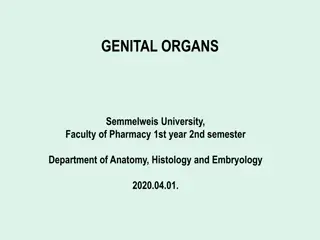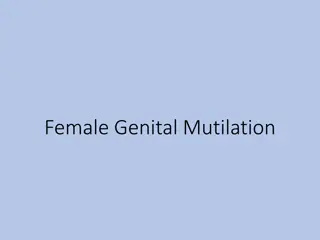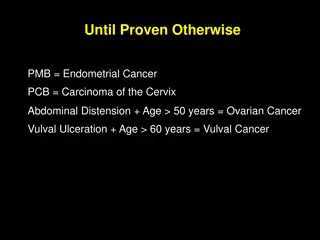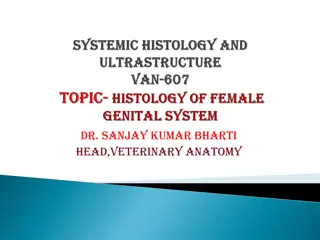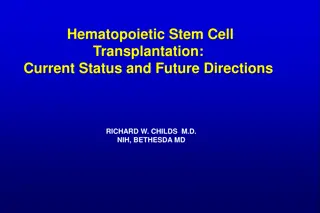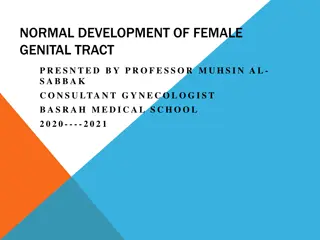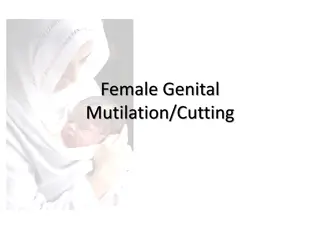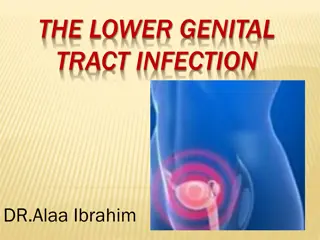Role of Lymphadenectomy in Genital Malignancies
Pelvic and paraaortic lymph node evaluation is crucial in the surgical staging of gynecological malignancies. The goals of lymph node dissection are to determine disease extent and guide further treatment. Pelvic lymph nodes include common iliac, external and internal iliac, obturator, sacral, and pararectal nodes. Paraaortic node dissection involves resection of nodal tissue along the vena cava. In cervical cancer, lymph node involvement guides treatment decisions, including radiation therapy. Endometrial cancer staging includes evaluating pelvic and paraaortic lymph nodes for prognostic information on extrauterine disease. Debulking of enlarged positive lymph nodes in cervical cancer is controversial.
- Lymphadenectomy
- Gynecological Malignancies
- Pelvic Lymph Nodes
- Paraaortic Node Dissection
- Cervical Cancer
Download Presentation

Please find below an Image/Link to download the presentation.
The content on the website is provided AS IS for your information and personal use only. It may not be sold, licensed, or shared on other websites without obtaining consent from the author. Download presentation by click this link. If you encounter any issues during the download, it is possible that the publisher has removed the file from their server.
E N D
Presentation Transcript
INTRODUCTION Pelvic and para aortic lymph node evaluation is a major component of the surgical staging procedure for several gynaecological malignancies. The surgical and oncologic goals of the lymph node dissection are to define the extent of disease and to guide further treatment.
The pelvic lymph nodes include the lower portion of the common iliac,external and internal iliac,obturator,sacral,and pararectal nodes. Pelvic node dissection includes bilateral removal of nodal tissue from the distal one half of each common iliac artery,the anterior and medial aspect of the proximal half of the external iliac artery and vein,and the distal half of the obturator fat pad anterior to the obturator nerve.
Paraaortic node dissection consists of resection of nodal tissue over the distal vena cava from the level of the inferior mesenteric artery to the mid right common iliac artery and between the aorta and the left ureter from the inferior mesenteric artery to the left mid common iliac artery.
ROLE OF LYMPHADENECTOMY IN GYNECOLOGIC MALIGNANCIES 1)CERVICAL CANCER In early stage cervical cancer,information regarding lymph node involvement helps to guide the treatment and the anatomic level chosen for volume directed radiation therapy in both early and advanced stage disease.
It is controversial whether debulking grossly enlarged positive lymph nodes is therapeutic in cervical cancer but some centres routinely remove bulky nodes in patients with advanced cervical cancer prior to definitive treatment with radiation and concurrent chemotherapy
2)ENDOMETRIAL CANCER Endometrial cancer is surgically staged. One of the most important prognostic factors for endometrial carcinoma is the presence of extrauterine disease,particularly pelvic and paraaortic lymph node metastases. Evaluation of pelvic and paraaortic lymph nodes is required as part of staging,but there is ongoing controversy about the mode of evaluation particularly in patients presumed to have early stage disease.
Possible approaches include pelvic and paraaortic palpation and sampling,selective lymphadenectomy based on frozen section criteria(grade,tumor size and depth of invasion),complete lymphadenectomy or sentinel node evaluation. The presence of pelvic and or paraaortic lymph node metastases determines whether chemotherapy with or without radiation is indicated and to what level the radiation may given.
3)Ovarian cancer Ovarian cancer is surgically staged. 75% of patients diagnosed with epithelial ovarian cancer present with stage 2 or higher disease. In those patients,a lymph node dissection is less useful prognostically and to guide treatment decisions.
It is important to remove suspicious or grossly enlarged nodes in patients with advanced disease undergoing tumor debulking with the goal of optimal cytoreductive surgery. For patients who have no apparent disease outside the ovaries,15 to 20 % will have lymph node involvement,with histologic grade being the most significant risk factor
Chemotherapy is indicated for patients with stage 1C or higher disease,so lymph node metastases are not the sole indication for postoperative therapy. However the absence of lymph node involvement is clinically significant for subsets of patients with surgically staged low risk epithelial,germ cell, and stromal ovarian malignancies who may be candidates for observation without adjuvant chemotherapy.
4)VULVAL CANCER The technique of superficial lymphadenectomy of the inguinal nodes above the cribriform fascia has been largely replaced by sentinel lymph node biopsy. The value of removing positive pelvic lymph nodes before radiotherapy is unknown. Pelvic lymphadenectomy is now rarely indicated in treatment of vulval cancer.
COMPLICATIONS Surgical complications in patients undergoing pelvic and paraaortic lymph node dissection are multifactorial and related to the patient age,existing comorbidities,surgical approach,operative duration and concurrent surgical procedures. Thromboembolic disease has been reported in 2 to 5% cases.
Complications related to lymphatic drainage are specific to the lymph node dissection. Lymphoedema is the most common complication. Edema can extend from the feet to the anterior abdominal wall and atypical places such as the mons pubis and upper thighs.
Another potential complication is lymphocele. Lymphoceles are often asymptomatic but can present as pelvic pressure or pain,may cause hydronephrosis secondary to external compression of ureter. Many patients may have drainage of lymphatic fluid from the vagina in the immediate postoperative period. It resolves within a few weeks.
Chylous ascites and lymphatic fistula are also seen in some patients. It will resolve with conservative management,but drain replacement,median chain fatty acid diet,somatostatin analogues or surgical correction may be required.




